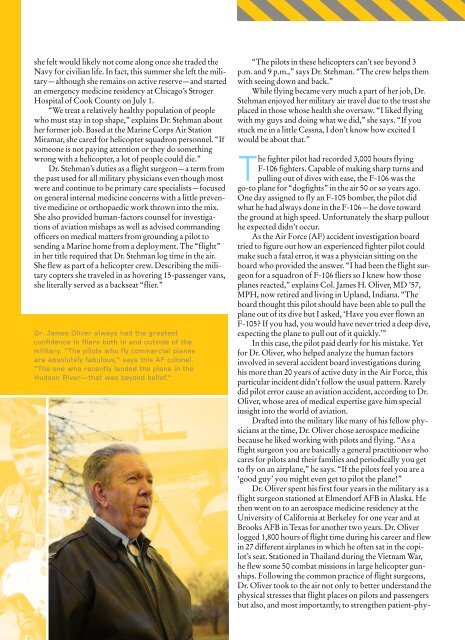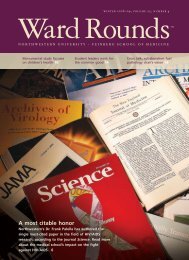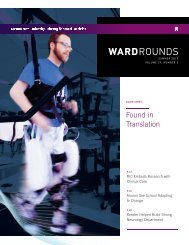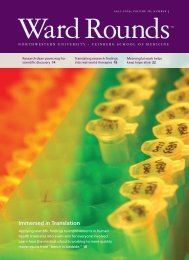Graduation World Tour 2009 - Ward Rounds - Northwestern University
Graduation World Tour 2009 - Ward Rounds - Northwestern University
Graduation World Tour 2009 - Ward Rounds - Northwestern University
You also want an ePaper? Increase the reach of your titles
YUMPU automatically turns print PDFs into web optimized ePapers that Google loves.
she felt would likely not come along once she traded theNavy for civilian life. In fact, this summer she left the military—althoughshe remains on active reserve—and startedan emergency medicine residency at Chicago’s StrogerHospital of Cook County on July 1.“We treat a relatively healthy population of peoplewho must stay in top shape,” explains Dr. Stehman abouther former job. Based at the Marine Corps Air StationMiramar, she cared for helicopter squadron personnel. “Ifsomeone is not paying attention or they do somethingwrong with a helicopter, a lot of people could die.”Dr. Stehman’s duties as a flight surgeon—a term fromthe past used for all military physicians even though mostwere and continue to be primary care specialists—focusedon general internal medicine concerns with a little preventivemedicine or orthopaedic work thrown into the mix.She also provided human-factors counsel for investigationsof aviation mishaps as well as advised commandingofficers on medical matters from grounding a pilot tosending a Marine home from a deployment. The “flight”in her title required that Dr. Stehman log time in the air.She flew as part of a helicopter crew. Describing the militarycopters she traveled in as hovering 15-passenger vans,she literally served as a backseat “flier.”Dr. James Oliver always had the greatestconfidence in fliers both in and outside of themilitary. “The pilots who fly commercial planesare absolutely fabulous,” says this AF colonel.“The one who recently landed the plane in theHudson River—that was beyond belief.”“The pilots in these helicopters can’t see beyond 3p.m. and 9 p.m.,” says Dr. Stehman. “The crew helps themwith seeing down and back.”While flying became very much a part of her job, Dr.Stehman enjoyed her military air travel due to the trust sheplaced in those whose health she oversaw. “I liked flyingwith my guys and doing what we did,” she says. “If youstuck me in a little Cessna, I don’t know how excited Iwould be about that.”The fighter pilot had recorded 3,000 hours flyingF-106 fighters. Capable of making sharp turns andpulling out of dives with ease, the F-106 was thego-to plane for “dogfights” in the air 50 or so years ago.One day assigned to fly an F-105 bomber, the pilot didwhat he had always done in the F-106—he dove towardthe ground at high speed. Unfortunately the sharp pullouthe expected didn’t occur.As the Air Force (AF) accident investigation boardtried to figure out how an experienced fighter pilot couldmake such a fatal error, it was a physician sitting on theboard who provided the answer. “I had been the flight surgeonfor a squadron of F-106 fliers so I knew how thoseplanes reacted,” explains Col. James H. Oliver, MD ’57,MPH, now retired and living in Upland, Indiana. “Theboard thought this pilot should have been able to pull theplane out of its dive but I asked, ‘Have you ever flown anF-105? If you had, you would have never tried a deep dive,expecting the plane to pull out of it quickly.’”In this case, the pilot paid dearly for his mistake. Yetfor Dr. Oliver, who helped analyze the human factorsinvolved in several accident board investigations duringhis more than 20 years of active duty in the Air Force, thisparticular incident didn’t follow the usual pattern. Rarelydid pilot error cause an aviation accident, according to Dr.Oliver, whose area of medical expertise gave him specialinsight into the world of aviation.Drafted into the military like many of his fellow physiciansat the time, Dr. Oliver chose aerospace medicinebecause he liked working with pilots and flying. “As aflight surgeon you are basically a general practitioner whocares for pilots and their families and periodically you getto fly on an airplane,” he says. “If the pilots feel you are a‘good guy’ you might even get to pilot the plane!”Dr. Oliver spent his first four years in the military as aflight surgeon stationed at Elmendorf AFB in Alaska. Hethen went on to an aerospace medicine residency at the<strong>University</strong> of California at Berkeley for one year and atBrooks AFB in Texas for another two years. Dr. Oliverlogged 1,800 hours of flight time during his career and flewin 27 different airplanes in which he often sat in the copilot’sseat. Stationed in Thailand during the Vietnam War,he flew some 50 combat missions in large helicopter gunships.Following the common practice of flight surgeons,Dr. Oliver took to the air not only to better understand thephysical stresses that flight places on pilots and passengersbut also, and most importantly, to strengthen patient-physicianrelationships. Close bonds help keep the lines ofcommunication open so that pilots feel comfortable discussingrather than hiding their health concerns. “Mostpilots are scared to death of doctors because they fearbeing grounded because of health reasons,” says Dr. Oliver.“You have the potential to ruin a pilot’s life.”In 1978 Dr. Oliver retired from the military althoughhe remains a “regular” officer and could still be called forduty. He went into private practice in preventive and generalinternal medicine first in Kansas and then Indiana andprovided Federal Aviation Administration (FAA)-required physicals for commercial and recreational pilotsas a certified FAA senior aeromedical examiner. He retiredfrom medicine in 2007.Dr. Oliver had the good fortune of combining twointerests—medicine and aviation—in a long and enjoyablecareer. He passed on the latter passion to son Bradley, nowan AF major and F-18 fighter pilot working at the Pentagonin Washington.When Jon M. Casbon, MD ’80, completed his familypractice residency at St. Joseph’s Hospital inPhoenix in 1984, it was time to pay back the AirForce for financing his <strong>Northwestern</strong> education.Although he completed training to become a flight surgeon,the Air Force had other plans. It first assigned Dr.Casbon to practice family and primary care medicine andthen steadily promoted him to leadership roles at bases inthe United States and Europe.Moving up in the ranks to his current position as anAF colonel stationed at Offutt AFB in Nebraska, Dr. Casbondidn’t practice aerospace medicine until August 2003when he became commander of the 89th Aerospace MedicineSquadron located at Andrews AFB in Maryland. Inthis role he led and directed some 160 military and civilianpersonnel in areas of aerospace medicine ranging fromflight medicine and bioenvironmental engineering to aeromedicalstaging for the reception and care of wounded soldiersreturning from Iraq and Afghanistan. He also got tosee a lot of “very important” people land and take off fromAndrews, home of the official U.S. presidential aircraftknown as “Air Force One.”“At Andrews I finally got to use the ‘wings’ I hadearned so many years before in flight surgery school,”remarks Dr. Casbon. “So in 2003 I had my first real exposureto the specialty and I decided, ‘Hey, I really like it.This is what I want to do,’ and that’s when I had mymidlife crisis!”So in 2005 at age 49, Dr. Casbon enrolled in the AirForce’s aerospace medicine residency program at BrooksAFB—one of only four accredited U.S. residency programsin the specialty. As part of the curriculum, he earnedan MPH degree at Johns Hopkins <strong>University</strong> in 2006. Ayear later he became board certified in aerospace medicineand then opted for a third year in his residency program toachieve accreditation in occupational medicine. Dr. Casboncompleted his training in July 2008 and moved on toAlthough he has served the Air Force for a quarterof a century, Dr. Jon Casbon had a “midlife crisis,”went back to school, and completed an aerospacemedicine residency in 2008.his next assignment as commander of the 55th MedicalOperations Squadron at Offutt AFB. In charge of guiding300 military and civilian personnel providing primary andspecialty care to 29,000 individuals, Dr. Casbon—ironically—doesnot have any aerospace medicine responsibilities.He does, however, serve as the base’s occupationalmedicine consultant in matters pertaining to flight medicineas well as traditional concerns of the specialty such ashearing protection, exposure to hazardous chemicals, andworkers’ compensation.“Aerospace medicine, like other specialties, has links topreventive as well as occupational medicine,” explains Dr.Casbon, who enjoys the epidemiological aspects of preventingdisease and reducing occupational hazards. “Aviator isan occupation, and there are many different types of aviationoccupations from flying to repairing planes.”In regard to his own career in aerospace medicine, Dr.Casbon is once again paying back the military for hisrecent graduate medical education. Although currently ina clinical role and not in charge of fliers, his situation couldchange. After all, in the past 12 years, he has moved every24 months to different AF jobs and bases. Says Dr. Casbon,who has already served 25 years in the military,“Well, the Air Force still has a commitment of a few moreyears from me due to my residency training, so you neverknow. I could get to use my wings in the future.”As Dr. Casbon and his fellow <strong>Northwestern</strong> alumnihave discovered, practicing the specialty of aerospacemedicine presents many opportunities outside the usualoffice environment that can take off at a moment’s notice.From flying off to the “wild blue yonder” to residing inspace as Dr. Barratt is now exploring, practitioners of thisunique area of medicine feel especially fortunate for theircolorful and exciting experiences—from below as well ashigh above the Earth’s atmosphere.wardroundsonline.com 13












